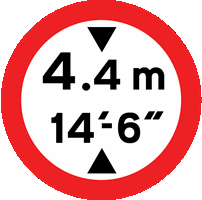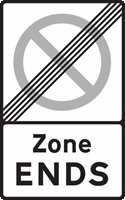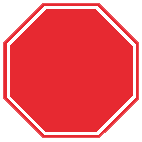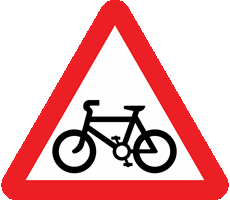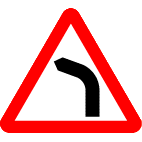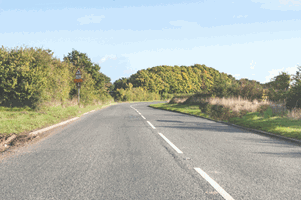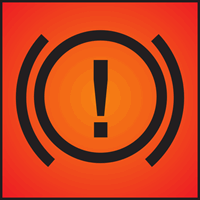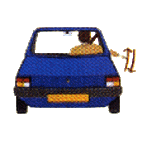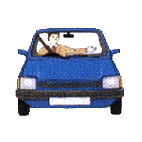You have 57 minutes to answer 50 multiple choice theory test questions. You need to answer at least 43 out of 50 questions correctly to pass. You can review your answer after each question or you can review all of your answers at the end of the test. Best of luck!
Test Quick View
Click on an answer to view the correct choice along with the explanation.
1. What THREE things should the driver of the grey car (arrowed) be especially aware of?
Mark three answers
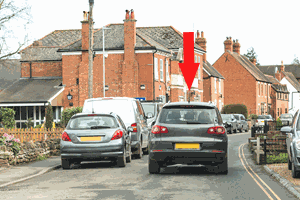
B
C
D
E
F
Correct Answer: A, B, E
Explanation: You need to be aware that other road users may not have seen you. Always be on the lookout for hazards that may develop suddenly and need you to take avoiding action.
Explanation: You need to be aware that other road users may not have seen you. Always be on the lookout for hazards that may develop suddenly and need you to take avoiding action.
Correct Answer: D
Explanation: You may have to pull forward slowly until you can see up and down the road. Be aware that the traffic approaching the junction can't see you either. If you don't know that it's clear, don't go.
Explanation: You may have to pull forward slowly until you can see up and down the road. Be aware that the traffic approaching the junction can't see you either. If you don't know that it's clear, don't go.
3. You are travelling behind a bus that pulls up at a bus stop. What should you do?
Mark two answers
B
C
D
Correct Answer: B, D
Explanation: There might be pedestrians crossing from in front of the bus. Look out for them if you intend to pass. Consider staying back and waiting.How many people are waiting to get on the bus? Check the queue if you can. The bus might move off straight away if there is no one waiting to get on.If a bus is signalling to pull out, give it priority as long as it is safe to do so.
Explanation: There might be pedestrians crossing from in front of the bus. Look out for them if you intend to pass. Consider staying back and waiting.How many people are waiting to get on the bus? Check the queue if you can. The bus might move off straight away if there is no one waiting to get on.If a bus is signalling to pull out, give it priority as long as it is safe to do so.
Correct Answer: B
Explanation: A red slash through this sign indicates that the restriction has ended. In this case the restriction was a minimum speed limit of 30 mph.
Explanation: A red slash through this sign indicates that the restriction has ended. In this case the restriction was a minimum speed limit of 30 mph.
5. Which THREE of the following are most likely to take an unusual course at roundabouts?
Mark three answers
B
C
D
E
F
Correct Answer: A, D, E
Explanation: Long vehicles might have to take a slightly different position when approaching the roundabout or going around it. This is to stop the rear of the vehicle cutting in and mounting the kerb. Horse riders and cyclists might stay in the left-hand lane although they are turning right. Be aware of this and allow them room.
Explanation: Long vehicles might have to take a slightly different position when approaching the roundabout or going around it. This is to stop the rear of the vehicle cutting in and mounting the kerb. Horse riders and cyclists might stay in the left-hand lane although they are turning right. Be aware of this and allow them room.
Correct Answer: A
Explanation: You can overtake other traffic on either side when travelling in a one-way street. Make full use of your mirrors and ensure that it's clear all around before you attempt to overtake. Look for signs and road markings and use the most suitable lane for your destination.
Explanation: You can overtake other traffic on either side when travelling in a one-way street. Make full use of your mirrors and ensure that it's clear all around before you attempt to overtake. Look for signs and road markings and use the most suitable lane for your destination.
Correct Answer: B
Explanation: If there is no-one on the crossing when the amber light is flashing, you may proceed over the crossing. You don't need to wait for the green light to show.
Explanation: If there is no-one on the crossing when the amber light is flashing, you may proceed over the crossing. You don't need to wait for the green light to show.
Correct Answer: B
Explanation: The triangular shapes above and below the dimensions indicate a height restriction that applies to the road ahead.
Explanation: The triangular shapes above and below the dimensions indicate a height restriction that applies to the road ahead.
Correct Answer: C
Explanation: Even though you have left the restricted area, make sure that you park where you won't endanger other road users or cause an obstruction.
Explanation: Even though you have left the restricted area, make sure that you park where you won't endanger other road users or cause an obstruction.
Correct Answer: D
Explanation: To make it easy to recognise, the 'stop' sign is the only sign of this shape. You must stop and take effective observation before proceeding.
Explanation: To make it easy to recognise, the 'stop' sign is the only sign of this shape. You must stop and take effective observation before proceeding.
Correct Answer: C
Explanation: It will take up to ten times longer to stop when it's icy. Where there is a risk of icy conditions you need to be aware of this and take extra care. If you think the road may be icy, don't brake or steer harshly as your tyres could lose their grip on the road.
Explanation: It will take up to ten times longer to stop when it's icy. Where there is a risk of icy conditions you need to be aware of this and take extra care. If you think the road may be icy, don't brake or steer harshly as your tyres could lose their grip on the road.
Correct Answer: B
Explanation: Where there's a cycle route ahead, a sign will show a bicycle in a red warning triangle. Watch out for children on bicycles and cyclists rejoining the main road.
Explanation: Where there's a cycle route ahead, a sign will show a bicycle in a red warning triangle. Watch out for children on bicycles and cyclists rejoining the main road.
Correct Answer: B
Explanation: Triangular signs give you a warning of hazards ahead. They are there to give you time to prepare for the hazard, for example by adjusting your speed.
Explanation: Triangular signs give you a warning of hazards ahead. They are there to give you time to prepare for the hazard, for example by adjusting your speed.
Correct Answer: B
Explanation: Obey the 'give way' signs. Trams are unable to steer around you if you misjudge when it is safe to enter the junction.
Explanation: Obey the 'give way' signs. Trams are unable to steer around you if you misjudge when it is safe to enter the junction.
Correct Answer: D
Explanation: Road markings will warn you of a hazard ahead. A single, broken line along the centre of the road, with long markings and short gaps, is a hazard warning line. Don't cross it unless you can see that the road is clear well ahead.
Explanation: Road markings will warn you of a hazard ahead. A single, broken line along the centre of the road, with long markings and short gaps, is a hazard warning line. Don't cross it unless you can see that the road is clear well ahead.
Correct Answer: C
Explanation: Try to plan your journey so that you can take rest stops. It's recommended that you take a break of at least 15 minutes after every two hours of driving. This should help to maintain your concentration.
Explanation: Try to plan your journey so that you can take rest stops. It's recommended that you take a break of at least 15 minutes after every two hours of driving. This should help to maintain your concentration.
Correct Answer: A
Explanation: Practise good observation in all directions before you emerge or make a turn. Proceed only when you're sure it's safe to do so.
Explanation: Practise good observation in all directions before you emerge or make a turn. Proceed only when you're sure it's safe to do so.
18. A bus has stopped at a bus stop ahead of you. Its right-hand indicator is flashing. You should
Mark one answer

B
C
D
Correct Answer: B
Explanation: Give way to buses whenever you can do so safely, especially when they signal to pull away from bus stops. Look out for people leaving the bus and crossing the road.
Explanation: Give way to buses whenever you can do so safely, especially when they signal to pull away from bus stops. Look out for people leaving the bus and crossing the road.
Correct Answer: A
Explanation: In some built-up areas, you may find the speed limit reduced to 20 mph. Driving at a slower speed will help give you the time and space to see and deal safely with hazards such as pedestrians and parked cars.
Explanation: In some built-up areas, you may find the speed limit reduced to 20 mph. Driving at a slower speed will help give you the time and space to see and deal safely with hazards such as pedestrians and parked cars.
Correct Answer: A
Explanation: Although cars are the least likely to be affected, crosswinds can take anyone by surprise. This is most likely to happen after overtaking a large vehicle, when passing gaps between hedges or buildings, and on exposed sections of road.
Explanation: Although cars are the least likely to be affected, crosswinds can take anyone by surprise. This is most likely to happen after overtaking a large vehicle, when passing gaps between hedges or buildings, and on exposed sections of road.
Correct Answer: C
Explanation: When you see this sign, look out for any direction signs and judge whether you need to signal your intentions. Do this in good time so that other road users approaching the roundabout know what you're planning to do.
Explanation: When you see this sign, look out for any direction signs and judge whether you need to signal your intentions. Do this in good time so that other road users approaching the roundabout know what you're planning to do.
Correct Answer: A
Explanation: You won't be able to see as far ahead in fog as you can on a clear day. You will need to reduce your speed so that, if a hazard looms out of the fog, you have the time and space to take avoiding action.Travelling in fog is hazardous. If you can, try and delay your journey until it has cleared.
Explanation: You won't be able to see as far ahead in fog as you can on a clear day. You will need to reduce your speed so that, if a hazard looms out of the fog, you have the time and space to take avoiding action.Travelling in fog is hazardous. If you can, try and delay your journey until it has cleared.
23. You are the first person to arrive at an incident where people are badly injured. Which THREE should you do?
Mark three answers
B
C
D
E
Correct Answer: A, B, D
Explanation: If you're the first to arrive at a crash scene the first concerns are the risk of further collision and fire. Ensuring that vehicle engines are switched off will reduce the risk of fire. Use hazard warning lights so that other traffic knows there's a need for caution. Make sure the emergency services are contacted, don't assume this has already been done.
Explanation: If you're the first to arrive at a crash scene the first concerns are the risk of further collision and fire. Ensuring that vehicle engines are switched off will reduce the risk of fire. Use hazard warning lights so that other traffic knows there's a need for caution. Make sure the emergency services are contacted, don't assume this has already been done.
24. You are following other vehicles in fog. You have your lights on. What else can you do to reduce the chances of being in a collision?
Mark one answer
B
C
D
Correct Answer: C
Explanation: When it's foggy use dipped headlights. This will help you see and be seen by other road users. If visibility is seriously reduced consider using front and rear fog lights. Keep a sensible speed and don't follow the vehicle in front too closely. If the road is wet and slippery you'll need to allow twice the normal stopping distance.
Explanation: When it's foggy use dipped headlights. This will help you see and be seen by other road users. If visibility is seriously reduced consider using front and rear fog lights. Keep a sensible speed and don't follow the vehicle in front too closely. If the road is wet and slippery you'll need to allow twice the normal stopping distance.
Correct Answer: A
Explanation: Don't ignore this warning light. A fault in your braking system could have dangerous consequences.
Explanation: Don't ignore this warning light. A fault in your braking system could have dangerous consequences.
Correct Answer: C
Explanation: By driving all four wheels there is improved grip, but this does not replace the skills you need to drive safely. The extra grip helps road holding when travelling on slippery or uneven roads.
Explanation: By driving all four wheels there is improved grip, but this does not replace the skills you need to drive safely. The extra grip helps road holding when travelling on slippery or uneven roads.
Correct Answer: C, D, E
Explanation: Long-distance driving can be boring. This, coupled with a stuffy, warm vehicle, can make you feel tired. Make sure you take rest breaks to keep yourself awake and alert. Stop in a safe place before you get to the stage of fighting sleep.
Explanation: Long-distance driving can be boring. This, coupled with a stuffy, warm vehicle, can make you feel tired. Make sure you take rest breaks to keep yourself awake and alert. Stop in a safe place before you get to the stage of fighting sleep.
28. You are driving on the motorway in windy conditions. When passing high-sided vehicles you should
Mark one answer
B
C
D
Correct Answer: A
Explanation: The draught caused by other vehicles could be strong enough to push you out of your lane. Keep both hands on the steering wheel to maintain full control.
Explanation: The draught caused by other vehicles could be strong enough to push you out of your lane. Keep both hands on the steering wheel to maintain full control.
Correct Answer: D
Explanation: If you have to park your vehicle in foggy conditions it's important that it can be seen by other road users. Try to find a place to park off the road. If this isn't possible leave it facing in the same direction as the traffic. Make sure that your lights are clean and that you leave your sidelights on.
Explanation: If you have to park your vehicle in foggy conditions it's important that it can be seen by other road users. Try to find a place to park off the road. If this isn't possible leave it facing in the same direction as the traffic. Make sure that your lights are clean and that you leave your sidelights on.
30. You are travelling at night. You are dazzled by headlights coming towards you. You should
Mark one answer
B
C
D
Correct Answer: C
Explanation: You will have additional hazards to deal with at night. Visibility may be very limited and the lights of oncoming vehicles can often dazzle you. When this happens don't close your eyes, swerve or flash your headlights, as this will also distract other drivers. It may help to focus on the left kerb, verge or lane line.
Explanation: You will have additional hazards to deal with at night. Visibility may be very limited and the lights of oncoming vehicles can often dazzle you. When this happens don't close your eyes, swerve or flash your headlights, as this will also distract other drivers. It may help to focus on the left kerb, verge or lane line.
31. You are approaching a zebra crossing where pedestrians are waiting. Which arm signal might you give?
Mark one answer
B
C
D
Correct Answer: A
Explanation: A 'slowing down' signal will indicate your intentions to oncoming and following vehicles. Be aware that pedestrians might start to cross as soon as they see this signal.
Explanation: A 'slowing down' signal will indicate your intentions to oncoming and following vehicles. Be aware that pedestrians might start to cross as soon as they see this signal.
32. You take some cough medicine given to you by a friend. What should you do before driving?
Mark one answer
B
C
D
Correct Answer: B
Explanation: Never drive if you have taken drugs, without first checking what the side effects might be. They might affect your judgement and perception, and therefore endanger lives.
Explanation: Never drive if you have taken drugs, without first checking what the side effects might be. They might affect your judgement and perception, and therefore endanger lives.
Correct Answer: A, B, D
Explanation: Wasting fuel costs you money and also causes unnecessary pollution. Ensuring your tyres are correctly inflated, avoiding carrying unnecessary weight, and removing a roof rack that is not in use, will all help to reduce your fuel consumption.
Explanation: Wasting fuel costs you money and also causes unnecessary pollution. Ensuring your tyres are correctly inflated, avoiding carrying unnecessary weight, and removing a roof rack that is not in use, will all help to reduce your fuel consumption.
Correct Answer: C
Explanation: A heavy load on your roof rack will reduce the stability of the vehicle because it moves the centre of gravity away from that designed by the manufacturer. Be aware of this when you negotiate bends and corners. If you change direction at speed, your vehicle and/or load could become unstable and you could lose control.
Explanation: A heavy load on your roof rack will reduce the stability of the vehicle because it moves the centre of gravity away from that designed by the manufacturer. Be aware of this when you negotiate bends and corners. If you change direction at speed, your vehicle and/or load could become unstable and you could lose control.
Correct Answer: B, D
Explanation: Drive extremely carefully when the roads are icy. When travelling on ice, tyres make virtually no noise and the steering feels unresponsive.In icy conditions, avoid harsh braking, acceleration and steering.
Explanation: Drive extremely carefully when the roads are icy. When travelling on ice, tyres make virtually no noise and the steering feels unresponsive.In icy conditions, avoid harsh braking, acceleration and steering.
36. You are driving along a wet road. How can you tell if your vehicle's tyres are losing their grip on the surface?
Mark one answer
B
C
D
Correct Answer: D
Explanation: If you drive at speed in very wet conditions your steering may suddenly feel lighter than usual. This means that the tyres have lifted off the surface of the road and are skating on the surface of the water. This is known as aquaplaning. Reduce speed but don't brake until your steering returns to a normal feel.
Explanation: If you drive at speed in very wet conditions your steering may suddenly feel lighter than usual. This means that the tyres have lifted off the surface of the road and are skating on the surface of the water. This is known as aquaplaning. Reduce speed but don't brake until your steering returns to a normal feel.
Correct Answer: D
Explanation: When leaving your vehicle unattended it is best to take valuables with you. If you can't, then lock them out of sight in the boot. If you can see valuables in your car, so can a thief.
Explanation: When leaving your vehicle unattended it is best to take valuables with you. If you can't, then lock them out of sight in the boot. If you can see valuables in your car, so can a thief.
38. You have just been overtaken by this motorcyclist who is cutting in sharply. You should
Mark one answer

B
C
D
Correct Answer: C
Explanation: If another vehicle cuts in too sharply, ease off the accelerator and drop back to allow a safe separation distance. Try not to overreact by braking sharply or swerving, as you could lose control. If vehicles behind you are too close or unprepared, it could lead to a crash.
Explanation: If another vehicle cuts in too sharply, ease off the accelerator and drop back to allow a safe separation distance. Try not to overreact by braking sharply or swerving, as you could lose control. If vehicles behind you are too close or unprepared, it could lead to a crash.
39. You are driving at 70 mph on a three-lane motorway. There is no traffic ahead. Which lane should you use?
Mark one answer
B
C
D
Correct Answer: B
Explanation: If the left-hand lane is free you should use it, regardless of the speed you're travelling.
Explanation: If the left-hand lane is free you should use it, regardless of the speed you're travelling.
40. Your vehicle is fitted with a hand-held telephone. To use the telephone you should
Mark one answer
B
C
D
Correct Answer: B
Explanation: Your attention should be on your driving at all times. Except in a genuine emergency never attempt to use a hand-held phone while on the move. It's illegal and very dangerous. Your eyes could wander from the road and at 60 mph your vehicle will travel about 27 metres (89 feet) every second.
Explanation: Your attention should be on your driving at all times. Except in a genuine emergency never attempt to use a hand-held phone while on the move. It's illegal and very dangerous. Your eyes could wander from the road and at 60 mph your vehicle will travel about 27 metres (89 feet) every second.
Correct Answer: C
Explanation: Urban clearways may be in built-up areas and their times of operation will be clearly signed. You should stop only for as long as is reasonable to pick up or set down passengers. You should ensure that you are not causing an obstruction for other traffic.
Explanation: Urban clearways may be in built-up areas and their times of operation will be clearly signed. You should stop only for as long as is reasonable to pick up or set down passengers. You should ensure that you are not causing an obstruction for other traffic.
Correct Answer: A, D, E
Explanation: If you are going to drive it's always the safest option not to drink at all. Don't be tempted - it's not worth it.
Explanation: If you are going to drive it's always the safest option not to drink at all. Don't be tempted - it's not worth it.
43. You are driving at night with full beam headlights on. A vehicle is overtaking you. You should dip your lights
Mark one answer
B
C
D
Correct Answer: A
Explanation: On full beam your lights could dazzle the driver in front. Make sure that your light beam falls short of the vehicle in front.
Explanation: On full beam your lights could dazzle the driver in front. Make sure that your light beam falls short of the vehicle in front.
Correct Answer: D
Explanation: It's easy to lose your way in an unfamiliar area. If you need to check a map or ask for directions, first find a safe place to stop.
Explanation: It's easy to lose your way in an unfamiliar area. If you need to check a map or ask for directions, first find a safe place to stop.
45. You are turning right onto a dual carriageway. What should you do before emerging?
Mark one answer
B
C
D
Correct Answer: A
Explanation: Before emerging right onto a dual carriageway make sure that the central reserve is deep enough to protect your vehicle. If it's not, you should treat it as one road and check that it's clear in both directions before pulling out. Neglecting to do this could place part or all of your vehicle in the path of approaching traffic and cause a collision.
Explanation: Before emerging right onto a dual carriageway make sure that the central reserve is deep enough to protect your vehicle. If it's not, you should treat it as one road and check that it's clear in both directions before pulling out. Neglecting to do this could place part or all of your vehicle in the path of approaching traffic and cause a collision.
Correct Answer: C
Explanation: Windscreen pillars can block your view, particularly at junctions. Those road users most at risk of not being seen are cyclists, motorcyclists and pedestrians. Never rely on just a quick glance.
Explanation: Windscreen pillars can block your view, particularly at junctions. Those road users most at risk of not being seen are cyclists, motorcyclists and pedestrians. Never rely on just a quick glance.
Correct Answer: C
Explanation: Try not to hold up a queue of traffic. Other road users may become impatient and this could lead to reckless actions. If you're driving a slow-moving vehicle and the road is narrow, look for a safe place to pull in. DON'T wave other traffic past since this could be dangerous if you or they haven't seen an oncoming vehicle.
Explanation: Try not to hold up a queue of traffic. Other road users may become impatient and this could lead to reckless actions. If you're driving a slow-moving vehicle and the road is narrow, look for a safe place to pull in. DON'T wave other traffic past since this could be dangerous if you or they haven't seen an oncoming vehicle.
Correct Answer: B
Explanation: Missing out intermediate gears when appropriate, helps to reduce the amount of time spent accelerating and decelerating - the time when your vehicle uses most fuel.
Explanation: Missing out intermediate gears when appropriate, helps to reduce the amount of time spent accelerating and decelerating - the time when your vehicle uses most fuel.
49. You are driving through a tunnel. Your vehicle catches fire. What should you do?
Mark one answer
B
C
D
Correct Answer: B
Explanation: The main dangers in a tunnel fire are suffocation and smoke. If you can do so safely it's better to drive a burning vehicle out of a tunnel. If you can't do this, pull over, switch off the engine, use hazard warning lights and phone immediately for help. It may be possible to put out a small fire but if it seems large do NOT tackle it!
Explanation: The main dangers in a tunnel fire are suffocation and smoke. If you can do so safely it's better to drive a burning vehicle out of a tunnel. If you can't do this, pull over, switch off the engine, use hazard warning lights and phone immediately for help. It may be possible to put out a small fire but if it seems large do NOT tackle it!
50. You are driving on a road that has a cycle lane. The lane is marked by a broken white line. This means that
Mark two answers
B
C
D
Correct Answer: C, D
Explanation: Where signs or road markings show lanes are for cyclists only, leave them free. Do not drive or park in a cycle lane unless it is unavoidable.
Explanation: Where signs or road markings show lanes are for cyclists only, leave them free. Do not drive or park in a cycle lane unless it is unavoidable.





